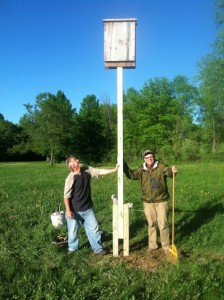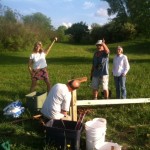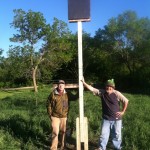People can see rare bats from around the world, including one with a 6-foot wing span, listen to top bat researchers and enjoy unique raffle prizes, hands-on activities and displays when the Wisconsin Bat Festival flies into Warner Park June 1.

The event runs from 10 a.m. to 6 p.m. at Warner Park Community Recreation Center, 1625 Northport Dr. in Madison. The admission is $5 for adults; children 16 and under are free with a paid adult admission.
New this year, “Bat Science Night” will follow the festival from 7-10 p.m., and is included as part of the admission to the festival. During this portion of the festjval, help local bat biologists as they use bat detectors and mist nets to demonstrate how the biologists catch the wild bats and “listen” for bats in the area.
All proceeds from the event go to the Wisconsin Bat Conservation Fund.
Wild Warner will also show off two new bat houses erected in the park by its members. The “houses” — two slabs of wood separated by a space — are used as nests and shelters.

“This is a great opportunity to see amazing, enormous wild bats close up in a way that even most zoos are not able to offer,” says Jennifer Redell, a Department of Natural Resources cave and mine specialist and coordinator of the event. “These bats are very beautiful and majestic and the diversity is pretty impressive. We’re excited to be able to give people a chance to look at them up close.”
The bats featured will include the world’s largest bat species, the Malayan Flying Fox, which has a nearly 6-foot wingspan. The event aims to raise awareness about the importance of bats, the role they play in our lives and our environment, and the threats they are facing, Redell says.
Other favorites from past years will be back: the chance to build a bat house, an inflatable cave for kids to explore, unique raffle prizes, hands-on activities, games, crafts and displays that allow attendees to discover the night-time secrets of bat biology, understand bat conservation needs, and learn how to become a Citizen Scientist for the Wisconsin Bat Program.

New this year presenters from the U.S.G.S. National Wildlife Health Center in Madison, the University of Wisconsin-Madison and DNR will address the latest research about the deadly bat disease white-nose syndrome and share how the state is addressing the threat of this devastating bat disease, Redell says.
“I’m really excited about our speaker line up this year,” Redell says. “Our whole event is very family friendly; I am glad we can offer something more in depth for people interested in the latest white-nose syndrome research.”
The U.S.G.S. wildlife center played a key role in identifying the disease and fungus and played a really important role in figuring out details about the disease that have really furthered scientists understanding how the bats being affected and why.
You must be logged in to post a comment.